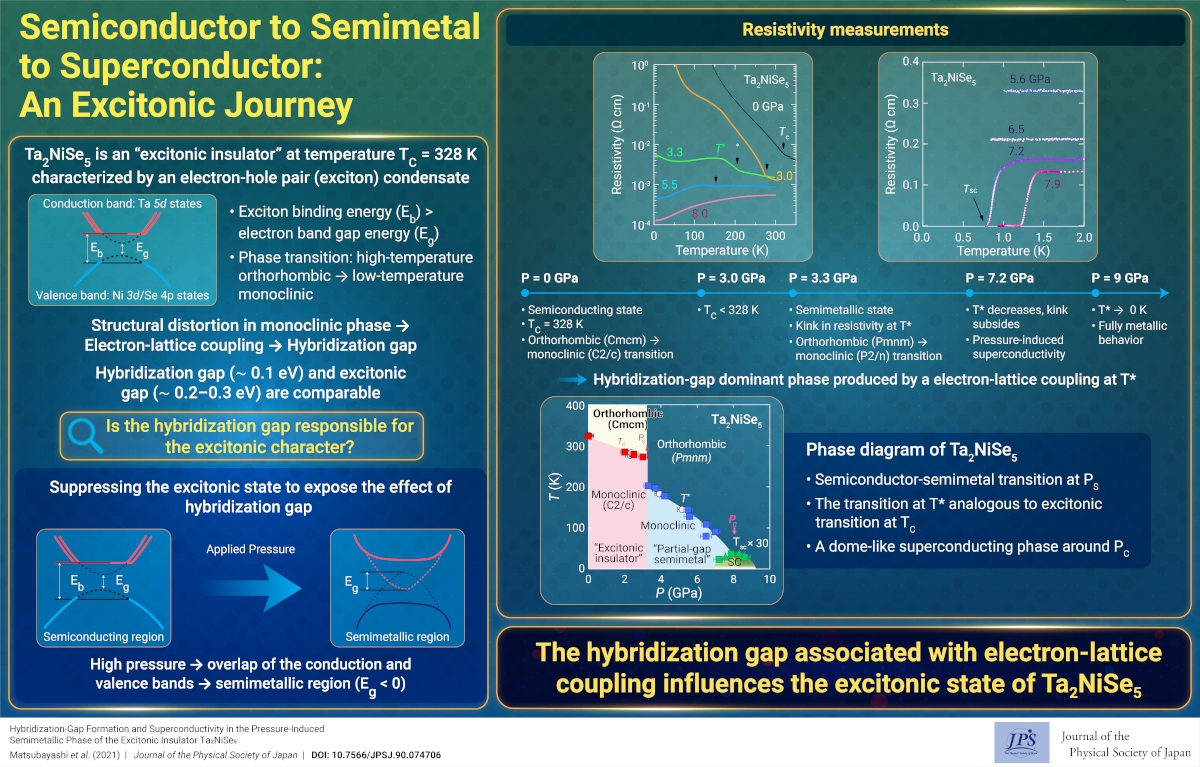Semiconductor to Semimetal to Superconductor: An Excitonic Journey
© The Physical Society of Japan
This article is on
Hybridization-gap Formation and Superconductivity in the Pressure-induced Semimetallic Phase of the Excitonic Insulator Ta2NiSe5
(JPSJ Editors' Choice)
J. Phys. Soc. Jpn. 90, 074706 (2021).
A phase diagram was constructed for Ta2NiSe5, a promising candidate for excitonic insulators, using high pressure as a tuning parameter. The results indicated pressure-induced superconductivity in the semimetallic phase.

Superconductors comprise a condensate of electron pairs, known as Cooper pairs, capable of electricity conduction without energy loss. Conventional superconductivity involves the formation of electron pairs via the attractive interactions mediated by lattice vibrations. Excitons are the bound states generated via Coulomb attraction between electrons and holes, similar to that for the Cooper pairs in superconductivity. The ineffective screening of Coulomb interactions in narrow-gap semiconductors and semimetals is expected to induce the spontaneous condensation of excitons with a decrease in temperature. Consequently, the system becomes an excitonic insulator.
Superconductivity was initially observed in mercury in 1911; subsequently, various superconducting materials, including high-temperature superconductors, were discovered. Conversely, the theoretical proposal of excitonic insulators over 50 years ago was not subsequently validated by conclusive experimental evidence of the excitonic state.
Ta2NiSe5 is a layered chalcogenide located near the semiconductor–semimetal boundary. Recently, this compound has attracted significant attention as a promising candidate for excitonic insulators. Furthermore, there is renewed interest in the formation of a gapped state driven by electron–lattice coupling. The applied pressure is an ideal controlling parameter to tune the electronic states. To the best of our knowledge, the present research was the first to report a high-pressure phase diagram for Ta2NiSe5 encompassing the entire range i.e., from the semiconducting to semimetallic region. The investigations revealed pressure-induced superconductivity in the semimetallic phase.
A transition to another semimetal with a partial gap was observed in the pressure-induced semimetallic phase. This was accompanied by lattice distortion analogous to that occurring during excitonic transition in the low-pressure semiconducting phase. An increase in the carrier density facilitated effective screening of the Coulomb interactions between electrons and holes. Therefore, the gap characteristics changed from excitonic dominant to hybridization-gap dominant with an increase in the band overlap under an applied pressure. The results revealed the critical role of electron–lattice coupling in the occurrence of superconductivity and excitonic transition in the low-pressure phase.(Written by Kazuyuki Matsubayashi on behalf of all authors.)
Hybridization-gap Formation and Superconductivity in the Pressure-induced Semimetallic Phase of the Excitonic Insulator Ta2NiSe5
(JPSJ Editors' Choice)
J. Phys. Soc. Jpn. 90, 074706 (2021).
Share this topic
Fields
Related Articles
-
Exploring Electronic States in BEDT-TTF Organic Superconductors
Superconductivity
Electronic transport in condensed matter
Magnetic properties in condensed matter
2024-4-24
This review, published in the Journal of the Physical Society of Japan, provides a comprehensive summary of the electronic states observed in BEDT-TTF type organic superconductors, including metal-insulator transitions, Mottness transitions, non-Fermi liquids, quantum spin liquids, and Bose-Einstein condensation.
-
Conversion of Chiral Phonons into Magnons in Magnets
Electronic transport in condensed matter
2024-4-1
A new phenomenon involving the conversion of chiral phonons into magnons is theoretically predicted. The effective magnetic field induced by chiral phonons causes a change in the spin magnetization of magnets.
-
Variety of Mechanically Induced Spin Currents in Rashba Systems
Electronic transport in condensed matter
Magnetic properties in condensed matter
Structure and mechanical and thermal properties in condensed matter
2024-3-22
Various types of spin currents, including unconventional types, are generated in Rashba spin-orbit coupled systems by dynamic lattice distortions associated with, for example, surface acoustic waves.
-
What Determines the Sign of Spin Current? ~ Theoretical Study of Spin Seebeck Effect in Antiferromagnetic Insulators
Electronic transport in condensed matter
2024-3-18
We developed a microscopic theory for the spin Seebeck effect in antiferromagnets, that explains the sign reversal of the spin current at the spin-flop transition point and describes the sorts of dominant carriers.
-
Chiral Anomalies in Organic Dirac Semimetals
Electronic transport in condensed matter
2024-2-5
A three-dimensional massless Dirac fermion system exhibiting broken chiral symmetry was successfully realized in organic conductor α-(BEDT-TTF)2I3 under high pressures. Our study detected the chiral anomaly-induced negative magnetoresistance and planar Hall effects and opened new avenues for further advancements in the field.
